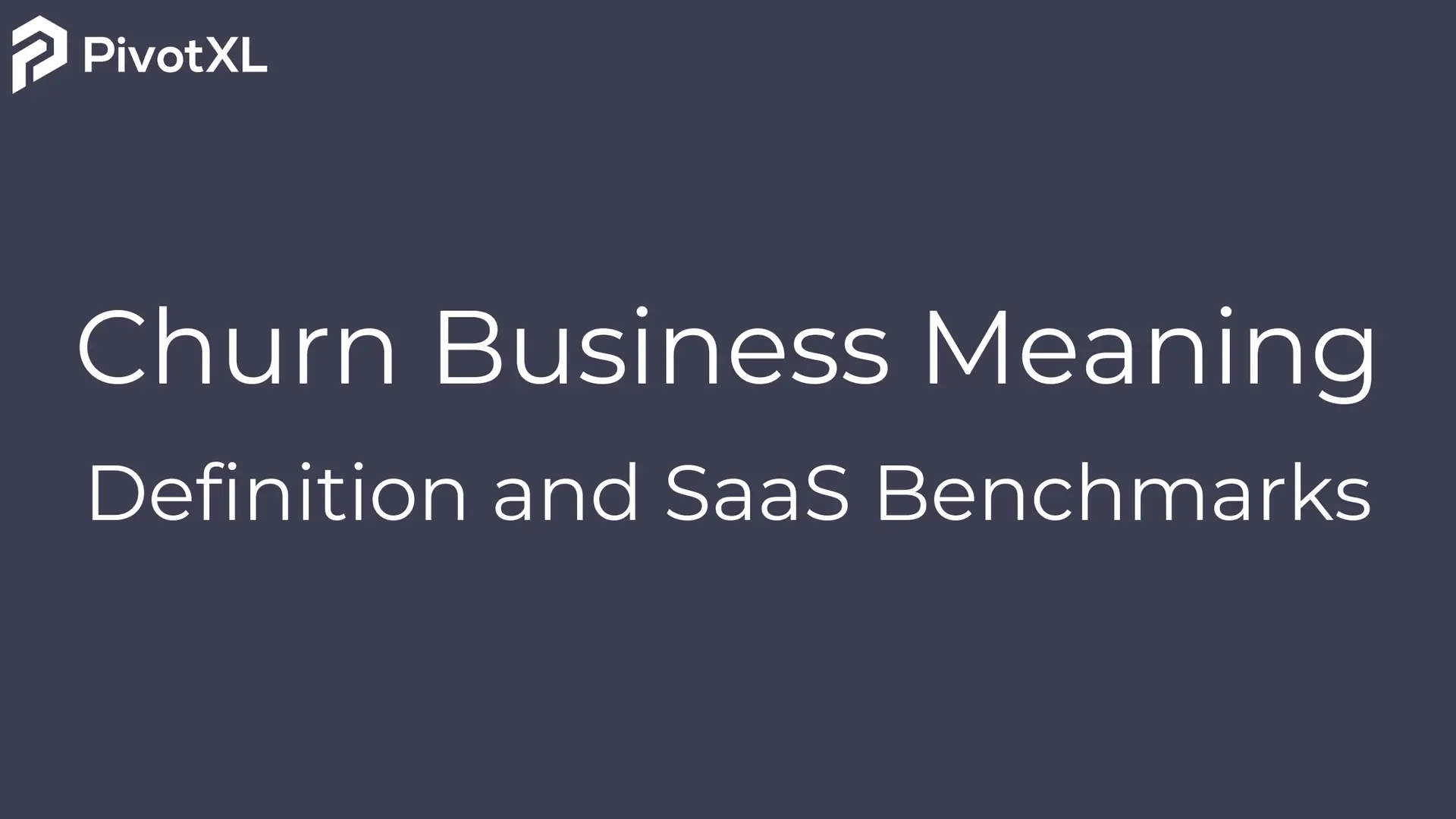Introduction
Analyzing the changes in a SaaS company’s customer numbers and revenue over time offers deep insights into its health and growth. One of the most critical metrics used to measure these changes is churn Business meaning rate.
So, what is churn rate?
The churn rate, also known as customer churn rate, is the percentage of customers who do not renew their subscriptions over a specified period, such as a month or a year. Companies also calculate revenue churn rate, which is the percentage of revenue a company loses over a given period due to customer cancellations.
Understanding and controlling churn is essential for SaaS businesses to maintain stable revenue streams and long-term growth. This blog explains how to calculate customer and revenue churn Business Meaning, strategies to reduce churn rates, and how your company compares to SaaS benchmarks.
Analyzing Churn in Your Business
Why is Churn Rate Important for SaaS Companies?
Churn rate is crucial for SaaS companies because it directly impacts long-term revenue stability. A high churn rate forces a business to spend more on customer acquisition just to maintain its current revenue.
For every lost customer, the company must acquire two new customers to achieve growth:
- One customer to replace the lost one.
- One additional customer to generate new revenue.
Since acquiring a new customer is significantly more expensive than retaining an existing one, high churn rates result in increased costs and reduced profitability.
The Compounding Effect of Churn
Churn doesn’t just affect revenue in the short term—it compounds over time.
For example, if your monthly churn rate is 3%, your total revenue loss may seem small initially. However, over time, the impact grows significantly:
- After 12 months, you could lose over 31% of your customers.
- If churn increases by just 2% (to 5%), that loss jumps to 54%.
As churn increases, the challenge of replacing lost revenue with new bookings becomes even harder. This is why reducing churn is critical for long-term sustainability.
Additional Business Insights from Churn Rate
Tracking churn rate can provide additional business insights, including:
Customer Lifetime Value (LTV)
Customer Lifetime = 1 / Monthly Churn Rate
This value is a key component of the LTV formula, which helps determine the average revenue each customer generates.
Net Revenue Retention (NRR)
NRR is directly correlated with valuation. Reducing churn improves NRR, making the company more attractive to investors.
Pricing and Packaging Insights
Tracking churn across different product tiers, customer segments, and regions can reveal whether pricing models need adjustments to improve retention.
How to Calculate Churn Rates?
The Correct Approach to Calculating Churn
SaaS companies should calculate churn business meaning based on customers whose contracts are due for renewal rather than all customers. This is important because:
- If your company offers annual or multi-year contracts, including all customers in churn business meaning calculations will artificially lower the churn rate.
Customer Churn Rate Formula
Customer Churn Rate = (Customers Lost During the Period / Customers Up for Renewal at the Start of the Period) × 100
Key Notes:
- The formula is applicable to any time period (monthly, quarterly, or annually).
- It considers only customers whose subscriptions are up for renewal, ensuring accuracy.
Revenue Churn Rate Formula
The revenue churn rate accounts for the offsetting effect of upgrades and expansions.
Revenue Churn Rate = [(ARR at End of Period – ARR at Start of Period – ARR from Upgrades) / ARR at Start of Period] × 100
Example: Churn Calculation for a SaaS Business
Assume a SaaS company has two product tiers:
- Basic: 10,000 customers paying $200/month
- Pro: 2,000 customers paying $800/month
- Total Monthly Recurring Revenue (MRR) = $3.6M
In one month:
- 400 Basic customers churn
- 50 Pro customers churn
Using the churn formulas, the company’s monthly customer churn rate is 3.75%.
What Affects Churn Rates?
Customer and revenue churn are primarily influenced by three key factors:
- Change in Ownership – If a business is acquired by a new parent company that uses different software or business models, it can lead to higher churn rates.
- Change of Sponsor – When the key decision-maker or product champion who initially purchased the product leaves the company, the risk of subscription cancellation increases.
- Customer Dissatisfaction – Various factors contribute to dissatisfaction, including poor customer service, slow time to value, ineffective onboarding, missing features, or unmet security requirements.
In addition to these, delinquent churn (also known as involuntary churn) occurs regardless of customer satisfaction with the product or service.
Common Causes of Delinquent Churn
- The credit card linked to the account has expired.
- The customer’s account has insufficient funds.
- The bank blocks the payment as a fraud prevention measure.
- A technical issue prevents the payment from processing.
According to industry benchmarks, SaaS companies lose over 1% of their customers annually due to delinquent churn. Businesses can mitigate this risk by implementing decline management strategies, such as account updater services or dynamic retry logic, to recover failed payments efficiently.
The Challenge with Churn Rate
Churn rate varies significantly across SaaS companies, making it difficult to establish a universal benchmark. Several factors contribute to these variations, including:
- Contract Length – The duration of customer contracts has a direct impact on churn rates. Companies offering annual or multi-year contracts tend to experience lower churn compared to those operating on monthly subscription models. Longer contracts limit the number of cancellation opportunities, providing businesses with more time to demonstrate value and strengthen customer relationships. In contrast, shorter contracts allow customers to reassess their subscription more frequently, leading to higher churn potential.
- Niche-Industry Price Benchmarks – The competitiveness of a company’s pricing in its specific market segment also plays a role in churn. SaaS businesses offering specialized or niche products often experience lower churn rates, particularly if switching to an alternative solution is costly or requires extensive implementation effort. If customers perceive a lack of equivalent or better alternatives, they are less likely to leave, reducing churn naturally.
- Insufficient Reporting Data – Reliable churn benchmarks are challenging to determine because only a small number of SaaS companies publicly share their churn metrics. Even when data is available, it is often presented as a broad range rather than a precise figure. Without comprehensive reporting across industries, it becomes difficult for companies to establish realistic churn benchmarks specific to their business model and customer base.
Given these variables, it’s essential to analyze your own company’s churn patterns rather than relying solely on industry-wide averages. But how do you determine if your churn rate is within an acceptable range or if it signals a serious problem?
What Is Your Ideal Churn Rate?
There is no universally ideal churn rate, as it depends on multiple factors, including business model, industry, customer acquisition cost, and target market. While comparing your churn rate with direct competitors can be useful, such data is often not publicly available.
However, according to SaaS Performance Benchmarks, companies with an annual recurring revenue (ARR) of up to $5 million typically experience:
- A median annual ARR churn rate of 12%
- A median annual customer churn rate of 14%
These figures serve as a general reference point, but your business should strive to analyze internal trends and customer feedback to determine an optimal churn rate for sustained growth. Incorporating churn metrics into your SaaS company’s continuous planning process can help you track the effectiveness of your customer retention efforts and make data-driven decisions to improve retention strategies.
How PivotXL Simplifies Churn Rate Tracking
PivotXL helps SaaS companies track and analyze churn effectively with:
- Automated Revenue Tracking – Real-time insights into customer retention and revenue trends.
- Advanced Churn Forecasting – Model different churn scenarios and predict revenue impact.
- Custom Dashboards – Track customer churn, revenue churn, and NRR in one place.
Conclusion
Churn rate is a critical metric that determines a SaaS company’s long-term success. While some churn is inevitable, strategies like improving retention, enhancing customer experience, and implementing data-driven churn analysis can help businesses maintain strong revenue growth.
Using PivotXL, businesses can automate churn tracking and forecast revenue trends, making it easier to take proactive measures against churn.




